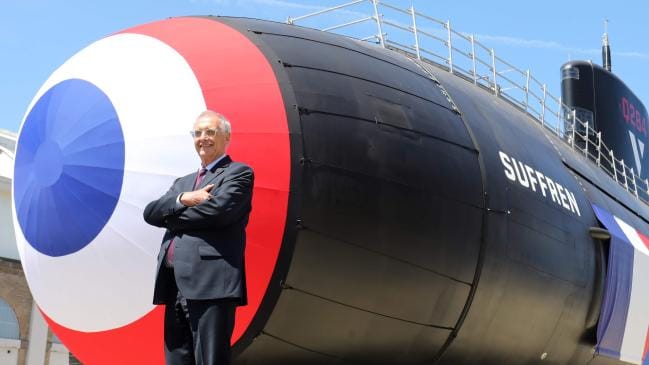
Headquartered in Sydney, with a presence in Melbourne and Adelaide, Naval Group Pacific will pioneer joint defence research partnerships with Australian universities and the CSIRO, as well as seeking involvement in the broadest range of Australian defence projects.
“It will be a regional hub for research and development,” Naval Group chairman Herve Guillou told The Australian ahead of Tuesday’s official announcement."
He said the subsidiary would work beyond submarines, although many areas of research, such as managing artificial intelligence in combat platforms, combating corrosion, and three-dimensional modelling had applications across submarines and other naval vessels.
He believed the subs project signalled “at least a 50-year strategic partnership” between France and Australia and the new company would seek to give life to that partnership.
Francois Romanet, who has been Naval Group’s general delegate in Australia for the past two years, will lead the new group.
The new company already has research agreements with the University of NSW and Flinders University.
The $50bn contract for the 12 conventional submarines is the biggest defence project Australia has embarked on, and Naval Group leaders, and the Morrison government, believe the project has the potential to transform Australian industry.
“Our endeavour is to develop a complete maritime industrial base in this country,” Mr Guillou said. “We must source a million parts for a submarine. We want to source most of them in Australia."
“A key to the strategic partnership is that because of the trust between Australia and France we are going to go far beyond the normal transfer of technology."
“So we will transfer not just the know-how but the know-what, which is the content of the intellectual property. And beyond that we will transfer the know-why. This is a key for sovereignty. Once we transfer the know-why then Australia has on its own soil the sovereign submarine capability.”
Mr Guillou said his company planned to hire 1800 Australians over the next 10 years and there would be at least a similar number of high-skill jobs in the industries around submarine building.
France and Australia’s close relationship with the US also enhanced the two nations’ working relationship.
“In terms of interoperability, the French Navy is probably the No 1 navy in intensity of co-operation with the US Navy, in the Indian Ocean and elsewhere,’’ Mr Guillou said. “Our two navies work very closely, although we don’t share too much technology with the Americans.”
Mr Guillou said naval ship- building had completely transformed over the past two decades.
Only 15 or 20 years ago, US companies dominated and lived in their giant domestic market. Russia dipped its toes abroad, and Europe was the main base for competition.
Now the Chinese build one frigate a month and one submarine every three months and their biggest naval shipbuilding company is the biggest in the world.
US companies occupy second and third place, with a Russian company, a successor of a state enterprise, No 4, and Naval Group fifth.
But new players are emerging on the market and the Japanese, as a result of bidding to build Australia’s future submarines, have become willing to participate in the global market.
The need for constant upgrades is changing the nature of submarine design as well, Mr Guillou said.
There has been much talk of unmanned submarine vehicles to be possibly launched from submarines. The first application of this, he said, would likely be in minesweeping and minehunting, but it was bound to develop as a huge element of naval capabilities.
Decades ago, Mr Guillou said, shipbuilders would bank on two generations of technology for a vessel. It would have a 40-year life span and halfway through it would be taken out of the water for one or two years and completely transformed. “Now we must be prepared for five to seven generations of technology in the life of one ship,’’ he said.
“We can’t have a big-bang change (with the ship out of the water for two years each time) so we have to change the architecture of our design to accommodate frequent upgrades.”
He believed there would be “incremental work” throughout the life of the Australian subs to ensure they remained regionally superior.
He did not think the initial delay in signing the strategic partnership agreement reflected poorly on the project.
“This is a strategic partnership for 50 years, it’s not just a business trade,’’ Mr Guillou said. “It concerns IP, governance, organisation, skills, sovereignty issues, shipyards, sustainment. It is not surprising that it takes two years to make sure such arrangements are sustainable.”

